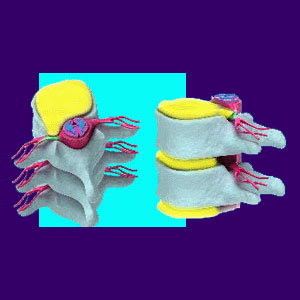
Degenerative disc disease treatment is one of the more controversial aspects of back and neck pain care, since DDD is a completely normal condition which typically requires no professional intervention at all. However, this does not stop many doctors and complementary caregivers from taking advantage of the patient’s ignorance and using DDD as an excuse to make a financial windfall at the patient’s expense.
The doctor should simply explain to the patient that this condition is nothing to fear. It is just a normal part of aging. The patient will be rest assured that nothing serious is wrong with their back and will most likely recover from any painful symptoms. This is treatment for degenerative disc disease in a perfect world and does not represent the way most doctors choose to handle the condition.
This discussion centers on the most common therapy modalities used to treat various manifestations of disc degeneration. If you are puzzled about which is the best form of degenerative disc disease treatment, we can help to clarify your many options and put you on the right path towards relief.
Need for Degenerative Disc Disease Treatment
Ironically, the actual medical associations governing physicians have warned that there is little correlation between any structural abnormality in the spine and the occurrence of painful symptoms.
Doctors have been advised not to diagnose dorsopathy based on structural degenerative conditions unless there is ironclad evidence of a causative process. In the case of DDD, the link to pain is especially weak, yet treatment for this degeneration found in any normal spine continues.
Unfortunately, many doctors choose to exploit DDD as a major cause for concern, rather than simply acknowledging that it is a completely normal and expected consequence of getting older. Since medicine cannot undo the aging process, or prevent the discs from degenerating, it must find some way to treat this condition.
Degenerative Disc Disease Treatment Options
Here are many of the most commonly utilized care methods for DDD:
Pain management drugs are given in large supplies, despite their risks and negative health consequences.
Chiropractic is an all-natural hands-on method of care that works well for many patients with an assortment of diagnoses.
Epidural injections serve several distinct purposes, but seem illogical for most cases of degenerative disc disease therapy.
Electrotherapy using TENS units can be provided at home or in a professional office setting.
Massage therapy will not work on the spinal anatomy directly, but can relax the patients and lead to favorable treatment outcomes according to direct patient citations.
Heat or ice therapy are cost-effective ways to manage many types of back and neck pain at home.
Physical therapy is widely used to treat dorsalgia conservatively. However, physical activity will have no effect on the spinal anatomy, so what is really the point?
For more information on all the available techniques that are used to treat degenerative disc disease, please see our section detailing back pain treatment.
DDD Treatment Patterns
All of these methods are symptomatic treatments. None of them offer the possibility for a real cure by enlarging the internal disc spaces. Some chiropractors will argue that regular adjustments will help to maintain or even re-create lost intervertebral disc space. This may be so in some patients, but there is a definite lack of evidence showing the universality of this claim and quite a bit of evidence demonstrating the contrary.
The best results for reshaping the spinal anatomy are those offered by spinal decompression systems which target specific intervertebral levels with precise accuracy. The DRX 9000 system, and the other forms of modern decompression, at least provide the possibility of actually doing something to alter the reason theorized for sourcing pain… That being the decreased intervertebral space. Decompression can expand this space and the results seem to endure after treatment ceases.
Degenerative disc disease surgery is another exception to the symptomatic methods of care. However, this is an treacherous proposition and is almost never actually needed. Spinal fusion and artificial disc replacement are the main modalities used and both have some possible benefits, but far more serious risk factors to consider.
Degenerative Disc Disease Treatment Conspiracy Theory
Medical science acknowledges that disc degeneration is universal in almost all people. It recognizes that the condition does not cause symptoms in the majority of people who have mild to moderate DDD.
Medical science does not offer many reliable cures for degenerative disc disease, even if treatment was needed. Spinal decompression and back surgery seem to be the only options for changing the anatomy of the intervertebral spaces. Remember, there is absolutely no evidence that says these anatomical features need to be changed at all.
What medical science does provide is ongoing symptomatic treatment. This also just so happens to be a very profitable sector of care, being that DDD is universal and will never resolve from these symptom-based modalities. Treatment can go on and on to the great economic benefit of doctors and therapists worldwide.
I do not think that most doctors are trying to rip off patients. I respect doctors. I feel they are trying to help. However, I also feel that if patients were educated on the real facts of intervertebral degeneration, there would not be many people suffering with the fear, pain and disability associated with this condition. Doctors certainly fall short of helping to achieve this goal, since they rarely explain the truth of DDD to their patients and often seek to capitalize on the diagnosis purely for financial gain. I see no evidence of degenerative disc disease treatment falling off in popularity or diversity anytime soon.
Back Pain > Degenerative Disc Disease > Degenerative Disc Disease Treatment





